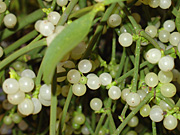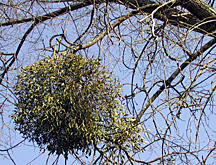Mistletoe
Christmas Decoration
Mistletoe makes a welcome appearance as a decoration in homes around Christmas time, particularly in English speaking countries.
There are many traditions associated with this plant, but perhaps the best known is that of kissing under the mistletoe – a tradition believed to have originated in Scandinavia, where is was known as the plant of peace.
Darker Side of Mistletoe
However, for the gardener, mistletoe has a darker side to its nature. For a start, some varieties are poisonous and can cause gastrointestinal problems diarrhoea and slow pulse. This plant also causes problems for the host trees in which it grows.
In many respects, mistletoe is similar to other plants with leaves and berries, but it differs from most in that it is parasitic.
It lives in the branches of trees and, instead of a conventional root system, it grows projections (haustoria) that are designed to penetrate the bark of the host tree from where the plant draws its supply of water, along with other nutrients it needs for growth.

In most cases, the host tree, suffering from the loss of water and nutrients, becomes weakened over a number of years. The branches that directly support the mistletoe are particularly vulnerable and often die. In fact, serious infestation can actually kill the tree, though this is likely to take a good number of years.
Mistletoe relies on birds, such as robins and thrushes for propagation. The birds eat the berries and then deposit the seeds when they visit other trees. The seeds, being sticky, glue themselves to the bark and start off a new colony.
Read Also:
Eliminating Mistletoe
You may be happy to have mistletoe in your tree and be willing to risk the loss of branches or possibly even the tree itself.
If, however, you particularly value the tree, you need to get rid of the mistletoe and the sooner you take action, the more successful you are likely to be. Unfortunately there is no effective means of destroying mistletoe without also affecting the tree.

Simply pruning away the visible part of the mistletoe leaves behind the roots that are embedded in the tree and only encourages regrowth.
To survive, mistletoe relies on nutrients from the host tree and therefore its survival depends on the welfare of the tree, or more particularly the welfare of the branch on which the mistletoe is growing.
The only effective way to eliminate mistletoe, therefore, is to prune out those branches that are infected. It is for this reason that you are better off taking action as early as possible after you identify the infection and before the parasite has the opportunity to spread to other parts of the tree or to neighbouring trees.
Unfortunately you cannot fully eliminate mistletoe other than by pruning out all affected branches, which in the case of heavy infestation, is an action that might itself kill the tree or leave it so disfigured that you no longer wish to keep it in your garden.
If the consequences of total elimination are not desirable, a compromise solution may be to focus on just those branches that are most heavily infected and leave those that are more lightly infected. Whilst this offers only a temporary respite, it has the effect of extending the life expectancy of the tree, possibly by many years.
Because the root system of mistletoe extends beyond the area of visible growth by as much as a foot or more in all directions, it is important that you take this into account when deciding how much of each infected branch to cut off.
